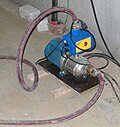Pump
Overview of medical pumps
Overview[edit]
A medical pump is a device used in healthcare settings to deliver fluids, such as nutrients and medications, into a patient's body in controlled amounts. They are commonly used in hospitals, nursing homes, and in home care settings. Medical pumps are essential for administering intravenous (IV) fluids, enteral feeding, and medication delivery.
Types of Medical Pumps[edit]
Medical pumps come in various types, each designed for specific applications:
Infusion Pumps[edit]
Infusion pumps are used to deliver fluids, such as nutrients and medications, into a patient's body in controlled amounts. They are commonly used in hospitals and other healthcare settings. Infusion pumps can deliver fluids at precise rates and volumes, which is crucial for patient safety and treatment efficacy.
Syringe Pumps[edit]
Syringe pumps are a type of infusion pump that uses a syringe to deliver precise amounts of fluid. They are often used for small volume infusions, such as in pediatric or neonatal care, where precise dosing is critical.
Enteral Pumps[edit]
Enteral pumps are used to deliver liquid nutrition directly to a patient's stomach or intestines. These pumps are essential for patients who cannot consume food orally and require enteral feeding.
Insulin Pumps[edit]
Insulin pumps are used by individuals with diabetes to deliver insulin continuously throughout the day. These pumps help maintain blood glucose levels within a target range and can be programmed to deliver different rates of insulin at different times of the day.
Components of a Medical Pump[edit]
A typical medical pump consists of several key components:
- Pump Mechanism: The core component that moves the fluid from the reservoir to the patient.
- Reservoir: A container that holds the fluid to be delivered.
- Tubing: Connects the reservoir to the patient, allowing fluid to flow.
- Control System: Allows healthcare providers to set the rate and volume of fluid delivery.
- Alarms and Alerts: Notify caregivers of any issues, such as occlusions or low battery.
Applications[edit]
Medical pumps are used in a variety of clinical settings:
- Chemotherapy: Infusion pumps are used to deliver chemotherapy drugs at precise rates to minimize side effects and maximize efficacy.
- Pain Management: Pumps can deliver pain medication continuously or on demand, providing effective pain control for patients.
- Parenteral Nutrition: For patients who cannot eat or absorb nutrients through the gastrointestinal tract, pumps deliver nutrients directly into the bloodstream.
Safety and Maintenance[edit]
Ensuring the safe operation of medical pumps is critical. Regular maintenance and calibration are necessary to ensure accuracy and reliability. Healthcare providers must be trained in the proper use of these devices to prevent errors in medication delivery.
Related Pages[edit]
Pump[edit]
-
Jet pump
-
Waterworks pump
-
Lobe pump
-
Lobe pump 3D animation
-
Vane pump
-
Hand pump
-
Old hand water pump
-
Gear pump
-
Lysholm screw rotors
-
Progressive cavity pump animation
-
Eccentric pump
-
Rope pump
Ad. Transform your life with W8MD's Budget GLP-1 injections from $75


W8MD offers a medical weight loss program to lose weight in Philadelphia. Our physician-supervised medical weight loss provides:
- Weight loss injections in NYC (generic and brand names):
- Zepbound / Mounjaro, Wegovy / Ozempic, Saxenda
- Most insurances accepted or discounted self-pay rates. We will obtain insurance prior authorizations if needed.
- Generic GLP1 weight loss injections from $75 for the starting dose.
- Also offer prescription weight loss medications including Phentermine, Qsymia, Diethylpropion, Contrave etc.
NYC weight loss doctor appointmentsNYC weight loss doctor appointments
Start your NYC weight loss journey today at our NYC medical weight loss and Philadelphia medical weight loss clinics.
- Call 718-946-5500 to lose weight in NYC or for medical weight loss in Philadelphia 215-676-2334.
- Tags:NYC medical weight loss, Philadelphia lose weight Zepbound NYC, Budget GLP1 weight loss injections, Wegovy Philadelphia, Wegovy NYC, Philadelphia medical weight loss, Brookly weight loss and Wegovy NYC
|
WikiMD's Wellness Encyclopedia |
| Let Food Be Thy Medicine Medicine Thy Food - Hippocrates |
Medical Disclaimer: WikiMD is not a substitute for professional medical advice. The information on WikiMD is provided as an information resource only, may be incorrect, outdated or misleading, and is not to be used or relied on for any diagnostic or treatment purposes. Please consult your health care provider before making any healthcare decisions or for guidance about a specific medical condition. WikiMD expressly disclaims responsibility, and shall have no liability, for any damages, loss, injury, or liability whatsoever suffered as a result of your reliance on the information contained in this site. By visiting this site you agree to the foregoing terms and conditions, which may from time to time be changed or supplemented by WikiMD. If you do not agree to the foregoing terms and conditions, you should not enter or use this site. See full disclaimer.
Credits:Most images are courtesy of Wikimedia commons, and templates, categories Wikipedia, licensed under CC BY SA or similar.
Translate this page: - East Asian
中文,
日本,
한국어,
South Asian
हिन्दी,
தமிழ்,
తెలుగు,
Urdu,
ಕನ್ನಡ,
Southeast Asian
Indonesian,
Vietnamese,
Thai,
မြန်မာဘာသာ,
বাংলা
European
español,
Deutsch,
français,
Greek,
português do Brasil,
polski,
română,
русский,
Nederlands,
norsk,
svenska,
suomi,
Italian
Middle Eastern & African
عربى,
Turkish,
Persian,
Hebrew,
Afrikaans,
isiZulu,
Kiswahili,
Other
Bulgarian,
Hungarian,
Czech,
Swedish,
മലയാളം,
मराठी,
ਪੰਜਾਬੀ,
ગુજરાતી,
Portuguese,
Ukrainian










